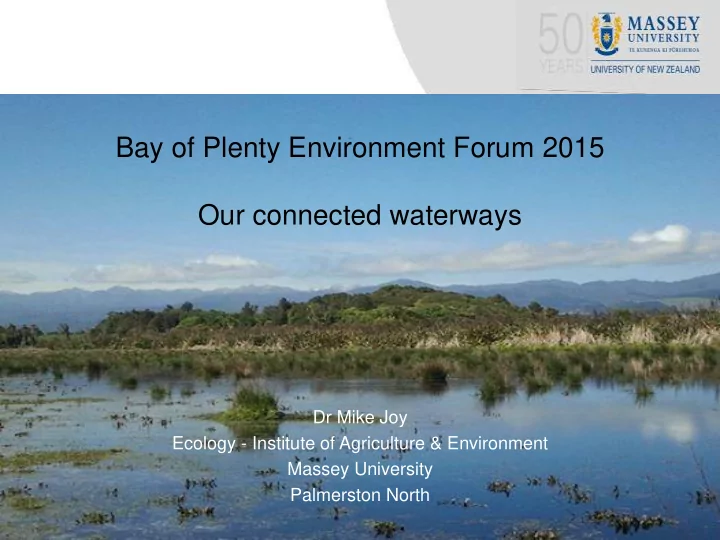

Bay of Plenty Environment Forum 2015 Our connected waterways Dr Mike Joy Ecology - Institute of Agriculture & Environment Massey University Palmerston North
Why should we care about our freshwater lakes and streams they are 100% pure aren't they? 1. Why we should care (the sad reality) = why what you are doing is so important 2. What the problems and causes are 3. What healthy freshwater ecosystems need 4. How to get them back there
Why should we care? Indigenous vegetation - Lost - > 70% indigenous vegetation and still losing it fast - Loss of native habitat in agricultural land - from 53% in 1950 to < 8% now = 68% ecosystems now listed as threatened Groundwater - steadily increasing N levels Lakes - Nutrients - 44% of NZ lakes “polluted” (>64 % in pasture catchments) = algal and cyanobacteria blooms, + sedimentation + pathogens …
Why should we care? Rivers and Estuaries Sedimentation – River beds higher than surrounding land in many places – pumps and stop banking - most harbours and estuaries are so choked with sediment from land-use change leading = big impacts on oceanic commercial fish species (NIWA) - in stream habitat loss for fish and insects Nutrients – excesses lead to oxygen fluctuation, mats of slime on stream beds, habitat loss, cant bathe …
Why should we care? Too much nutrient the Manawatu example
Why should we care? Nitrate ANZECC trigger level
Insect community index MCI Healthy Doubtful Moderate pollution Severe pollution
Why should we care? Human health - pathogens E. coli NZ now has the highest frequency per-capita globally of coliform enteritis, campylobacteriosis, cryptosporidiosis and salmonellosis 18 – 34K NZers contract waterborne diseases p.a. - benthic cyanobacteria mats (already killing dogs and horses and one day children)
Why should we care? Pathogens Ministry of health risk level
Why should we care? B iodiversity - 33 % of all spp. threatened or at risk ++ - 74% of freshwater fish ++ No. of NZ Species Threatened and At Risk 4000 3500 Taxa Threatened and At Risk 3000 2500 2000 1500 1000 500 0 1997 2002 2005 2008/11 Year
Why should we care? The government response to the crisis – lies and denial
“A fresh start for freshwater” NPS objectives 2014 : (making the problem dissapear) A B C NOF 2014 bottom line ANZECC 2000 guideline
“A fresh start for freshwater” NPS objectives 2014 : (making the problem disappear) Primary contact (health ministry Secondary contact level) (safe in a boat?)
What is not in the National Objectives Framework: Temperature, O 2 , physical impacts, groundwater, estuaries, offshore impacts, benthic cyanobacteria, pathogens, clarity.
Clearly the government has failed so I guess its up to us now – all power to community groups
Healthy waterways what do they need? How can we help them? If we make it suitable for the native fish – covers pretty much everything.
What's different about our fish? – Benthic, diadromous*3, nocturnal, cryptic, not herbivorous, mostly endemic and threatened, not tolerant. What do the fish need ? Water Access up and down (flap gates, dams, irrigation intakes) Habitat = cover - interstitial spaces, food, oxygen, temperature, clarity, Recruitment = spawning habitat,
The sides in flood
What's different about our fish? – Benthic, diadromous*3, nocturnal, cryptic, not herbivorous, mostly endemic and threatened, not tolerant. What do the fish need ? Water Access up and down (flap gates, dams, irrigation intakes) Habitat = cover - interstitial spaces, food, oxygen, temperature, clarity, Recruitment = spawning habitat,
2m
How sediment effects stream life Direct effects Indirect effects Suspended sediment Choking blocking gills Deterring migrating fish and bugs fish, starving visual feeders, lowering productivity by restricting sunlight Deposited sediment Removing habitat, Loss of substrate for blocking interstitial periphyton to attach spaces, crunchy food to for grazers
Restoration and protection of our waterways: 1. At the higher level the best cheapest & easiest way to protect waterways is not to pollute or damage them in the first place, so its vital to be involved in advocacy and protection (be political & vocal) 2. At the ‘coal face’ its riparian planting, removing barriers, reinstating & restoring wetlands, protecting & replanting catchments, monitoring being the eyes of the councils … 3. Start at the top and work down the catchment for water quality and for fish passage start at the bottom and work up
The role of science in an environmental crisis? • The role of citizen science in an environmental crisis • How community restoration and monitoring groups can work with the NPS to truly protect and restore freshwater environments • Monitoring (SEV, SHAP, RIT) • Education • Restoration action http://www.envirolink.govt.nz/PageFiles/31/Stream%20Habitat%20Assessment%20Prot • ocols.pdf http://www.niwa.co.nz/sites/niwa.co.nz/files/import/attachments/Restoration- • Indicators-4-WEB.pdf
Recommend
More recommend